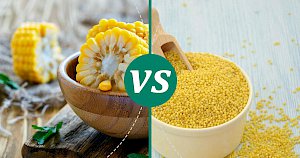Millet vs Corn: Nutrition & Calories Compare


Millet vs Corn
Nutrition Facts
Serving size:
change
5g10g15g20g30g40g50g60g80g100g120g140g160g180g200g220g250g300g350g400g450g500g600g700g800g900g1000g
1oz2oz3oz4oz5oz6oz7oz8oz10oz12oz15oz20oz25oz30oz35oz40oz50oz
Amount Per Serving:
Serving size:
change
5g10g15g20g30g40g50g60g80g100g120g140g160g180g200g220g250g300g350g400g450g500g600g700g800g900g1000g
1oz2oz3oz4oz5oz6oz7oz8oz10oz12oz15oz20oz25oz30oz35oz40oz50oz
Amount Per Serving:
Millet vs Corn 100g Compare
| per 100g | Millet | Corn |
|---|---|---|
| Calories | 378 | 86 |
| Carbohydrates | 72.85 g | 14.69 g |
| Fat | 4.22 g | 1.63 g |
| Saturated fat | 0.6 g | 0.3 g |
| Dietary fiber | 8.5 g | 2.43 g |
| Protein | 11.02 g | 2.79 g |
| Water | 8.67 g | 80.25 g |
| Calcium | 8 mg | 0.656 mg |
| Iron | 3.01 mg | 0.388 mg |
| Magnessium | 114 mg | 25.76 mg |
| Phosphorus | 0.9 mg | 2.513 mg |
| Potassium | 195 mg | 237 mg |
| Zink | 0.9 mg | 2.513 mg |
| Vitaminium B1 (Thiamine) | 0.421 mg | 0.079 mg |
| Vitaminium B2 (riboflavin) | 0.29 mg | 0.138 mg |
| Vitaminium B3 (Niacin) | 4.72 mg | 1.593 mg |
| Vitaminium B6 | 0.384 mg | 0.15 mg |
| Vitaminium B9 (Folic acid) | 0.085 mg | 42 mg |
| Vitaminium E | 0.05 mg | 0.07 mg |
| Vitaminium K | 0.001 µg | 0.3 µg |
A Journey Through the Grains: Millet vs. Corn
When it comes to grains, millet and corn are like the unsung heroes of the culinary world. Each has its own set of fascinating facts that not only pique our interest but also reveal their importance in global diets. For instance, did you know that millet is one of the oldest foods known to humanity? It has been the staple diet of millions in Africa and Asia for thousands of years. On the other hand, corn, also known as maize, was first domesticated by indigenous peoples in southern Mexico about 10,000 years ago, and it has since become a cornerstone of food cultures worldwide.
While both grains play a pivotal role in feeding the global population, they come with their own unique nutritional profiles and benefits. Let's delve into some aspects that highlight the differences and similarities between millet and corn, extending beyond just their nutritional data.
Culinary Versatility: A Tale of Two Grains
Millet and corn, though both grains, couldn't be more different in terms of their culinary uses and versatility. Millet, with its mildly sweet, nut-like flavor, is incredibly versatile. It can be cooked up as a fluffy side dish, transformed into porridge, or even used to make bread and beer. Its gluten-free nature also makes it a favorite among those with dietary restrictions.
Corn, on the other hand, is a staple in many countries and is consumed in various forms - from popcorn to cornbread, polenta, and sweet corn. Its sweet, robust flavor makes it a popular addition to a myriad of dishes, enhancing flavors and textures.
Nutritional Insights: More Than Just Numbers
Looking at the nutritional content, millet boasts a higher calorie count with 378 calories per 100 grams compared to corn's 86 calories, making millet a more energy-dense option. Millet also leads in terms of protein and fiber content, offering 11.02 grams of protein and 8.5 grams of fiber, against corn's 3.27 grams of protein and 2 grams of fiber. This makes millet an excellent choice for those looking to boost their protein and fiber intake.
However, corn is not without its merits. It has a higher water content, which can be beneficial for hydration and weight management. Additionally, corn offers more vitamin A and potassium than millet, which are crucial for maintaining good vision and heart health, respectively.
Both grains are naturally gluten-free and contain no cholesterol, making them heart-healthy choices for those managing their cholesterol levels or with gluten sensitivities.
Environmental Footprint: Growing Green
When considering the environmental impact of growing millet vs. corn, millet often comes out on top as the more sustainable option. Millet requires significantly less water and can thrive in poor soil conditions without the need for fertilizers. This makes it an eco-friendly crop that can be grown in arid regions where water scarcity is a concern.
Corn, while versatile and widely consumed, often requires more resources in terms of water, fertilizers, and pesticides. However, advancements in agricultural practices are continually seeking ways to reduce the environmental footprint of corn production.
Final Thoughts: A Grain for Every Plate
In the end, choosing between millet and corn boils down to personal preference, dietary needs, and environmental considerations. Both grains offer unique flavors, nutritional benefits, and culinary uses that can enrich our diets. Whether you're looking to add more protein and fiber with millet or enjoy the sweet versatility of corn, incorporating these grains into your meals can lead to a healthier, more sustainable diet.
Exploring the diverse world of grains like millet and corn not only broadens our culinary horizons but also connects us to the rich tapestry of global food cultures. So, why not make room on your plate for both of these remarkable grains?
Millet 100g
378kcalCalories source
- 78% CARBS.
- 12% PROTEIN
- 10% FAT
Corn 100g
86kcalCalories source
- 69% CARBS
- 13% PROTEIN
- 17% FAT
100g | ounce | single piece | tablespoon | teaspoon | cup | half cup | small can | medium can
Compares of millet
- Millet vs Couscous
- Millet vs Cooked Pasta
- Millet vs Brown Rice
- Millet vs Amaranth
- Millet vs Quinoa
- Millet vs Buckwheat
- see all compares of millet
Compares of corn
- see all compares of corn
Marcin Piotrowicz
calories-info.com creator
Healthy diet and healthy lifestyle promoter
Add comment